Changes in Extreme Temperature Events and Their Contribution to Mean Temperature Changes during Historical and Future Periods over Mainland China
Abstract
:1. Introduction
2. Materials and Methods
2.1. Material Sources
2.1.1. Historical Observation Data
2.1.2. Future Climate Scenario Data
2.2. Methods
2.2.1. Extreme Temperature Indices
2.2.2. Multi-Model Evaluation Method
2.2.3. Trend Analysis
2.2.4. Multiple Linear Regression Analysis
3. Results
3.1. Temporal and Spatial Variations in Tmean and Extreme Temperature Events in Mainland China during Historical Periods
3.1.1. Temporal and Spatial Variations in Tmean during Historical Periods
3.1.2. Temporal Variations in Extreme Temperature Events during Historical Periods
3.1.3. Spatial Variations in Extreme Temperature Events during Historical Periods
3.2. Effectiveness Evaluation of Historical Climate Models of CMIP6
3.3. Temporal and Spatial Variations in Tmean and Extreme Temperature Events Based on MME in Mainland China during Future Periods
3.3.1. Temporal and Spatial Variations in Tmean during Future Periods
3.3.2. Temporal Variations in Extreme Temperature Events during Future Periods
3.3.3. Spatial Variations in Extreme Temperature Events during Future Periods
3.4. The Relative Importance of Extreme Temperature Events to the Change in Tmean
4. Discussion
5. Conclusions
- (1)
- Spatial scale is particularly important for regional research. From 1961 to 2013, Tmean showed an increasing trend at a rate of 0.27 °C/10a at the mainland China scale. TX10p and TN10p showed significant decreases at rates of −1.94 days/10a and −4.11 days/10a at the mainland China scale, while TX90p and TN90p showed significant increases at rates of 2.61 days/10a and 4.97 days/10a, respectively. The rate of increase in Tmean and extreme temperature events in the Continental Basin, Southwest Basin and Yellow River Basin were higher than those at the mainland China scale.
- (2)
- The MME is the best model for simulating extreme temperature events in mainland China. For the CMIP6 simulation of extreme temperature events in mainland China, among the single CMIP6 global climate models, the simulation with MME is the closest to the observed value.
- (3)
- Climate change in mainland China will continue to intensify in the future. Under the SSP1-2.6, SSP2-4.5, and SSP5-8.5 scenarios, Tmean at the mainland China scale will continue to increase at rates of 0.11 °C/10a, 0.31 °C/10a and 0.75 °C/10a, and the changes in the Continental Basin and Songhua and Liaohe River Basin will be larger than those at the mainland China scale. Extreme cold events will continue to decrease, while extreme warm events will continue to increase, with the largest changes in the Songhua and Liaohe River Basin, followed by the Continental Basin.
- (4)
- The extreme temperature events related to Tmin have an important influence on the changes in the mainland China Tmean. The extreme temperature event that had an important influence on the Tmean at the mainland China scale and at different basin scales was TN10p in the historical period. Under different SSP scenarios in the future, the TN90p will have an important influence on the Tmean at the mainland China scale and at different basin scales.
Author Contributions
Funding
Institutional Review Board Statement
Informed Consent Statement
Data Availability Statement
Conflicts of Interest
References
- Arias, P.; Bellouin, N.; Coppola, E.; Jones, C.; Krinner, G.; Marotzke, J.; Naik, V.; Plattner, G.-K.; Rojas, M.; Sillmann, J.; et al. Climate Change 2021: The Physical Science Basis; Contribution of Working Group I to the Sixth Assessment Report of the Intergovernmental Panel on Climate Change; Technical Summary; IPCC: Geneva, Switzerland, 2021. [Google Scholar]
- Ipcc; Stocker, T.; Qin, D.; Plattner, G.-K.; Tignor, M.; Allen, S.K.; Boschung, J.; Nauels, A.; Xia, Y.; Bex, V.; et al. The physical science basis. Contribution of Working Group I to the Fifth Assessment Report of the Intergovernmental Panel on Climate Change. In Climate Change 2013; IPCC: Geneva, Switzerland, 2013. [Google Scholar]
- Ly, M.; Traore, S.; Alhassane, A.; Sarr, B. Evolution of some observed climate extremes in the West African Sahel. Weather Clim. Extrem. 2013, 1, 19–25. [Google Scholar] [CrossRef] [Green Version]
- Murray, V.; Mcbean, G.M.; Bhatt, M.; Borsch, S.; Suarez, A. Managing the risks of extreme events and disasters to advance climate change adaptation. J. Clin. Endocrinol. Metab. 2012, 487–542. [Google Scholar] [CrossRef]
- New, M.; Hewitson, B.; Stephenson, D.; Tsiga, A.; Kruger, A.; Manhique, A.; Gomez, B.; Coelho, S.; Masisi, D.; Kululanga, E.; et al. Evidence of trends in daily climate extremes over southern and west Africa. J. Geophys. Res. 2006, 111. [Google Scholar] [CrossRef]
- De los Milagros Skansi, M.; Brunet, M.; Sigró, J.; Aguilar, E.; Groening, J.A.A.; Bentancur, O.J.; Geier, Y.R.C.; Amaya, R.L.C.; Jácome, H.; Ramos, A.M.; et al. Warming and wetting signals emerging from analysis of changes in climate extreme indices over South America. Glob. Planet. Change 2013, 100, 295–307. [Google Scholar] [CrossRef]
- Schiermeier, Q. Droughts, heatwaves and floods: How to tell when climate change is to blame. Nature 2018, 560, 20–22. [Google Scholar] [CrossRef] [Green Version]
- Chen, Y.; Zhou, B.; Zhai, P.; Moufouma-Okia, W. Half-a-Degree Matters for Reducing and Delaying Global Land Exposure to Combined Daytime-Nighttime Hot Extremes. Earth's Future 2019, 7, 953–966. [Google Scholar] [CrossRef]
- Easterling, D.; Evans, J.; Groisman, P.; Karl, T.R.; Kunkel, K.; Ambenje, P. Observed Variability and Trends in Extreme Climate Events: A Brief Review. Bull. Am. Meteorol. Soc. 2000, 81, 417–426. [Google Scholar] [CrossRef] [Green Version]
- Zhang, X.; Alexander, L.; Hegerl, G.C.; Jones, P.; Tank, A.K.; Peterson, T.C.; Trewin, B.; Zwiers, F.W. Indices for monitoring changes in extremes based on daily temperature and precipitation data. Wiley Interdiscip. Rev. Clim. Change 2011, 2, 851–870. [Google Scholar] [CrossRef]
- Dong, S.; Sun, Y.; Aguilar, E.; Zhang, X.; Peterson, T.; Song, L.; Zhang, Y. Observed changes in temperature extremes over Asia and their attribution. Clim. Dyn. 2018, 51, 339–353. [Google Scholar] [CrossRef] [Green Version]
- Xi, Y.; Miao, C.; Wu, J.; Duan, Q.; Li, M. Spatiotemporal Changes in Extreme Temperature and Precipitation Events in the Three-Rivers Headwater Region, China. J. Geophys. Res. Atmos. 2018, 123, 5827–5844. [Google Scholar] [CrossRef]
- Alexander, L.; Zhang, X.; Peterson, T.C.; Caesar, J.; Ba, G.; Tank, A.; Haylock, M.; Collins, D.; Trewin, B.; Rahimzadeh, F.; et al. Global Observed Changes in Daily Climate Extremes of Temperature and Precipitation. J. Geophys. Res. 2006, 111. [Google Scholar] [CrossRef] [Green Version]
- Vincent, L.A.; Mekis, é. Changes in Daily and Extreme Temperature and Precipitation Indices for Canada over the Twentieth Century. Atmos. -Ocean 2006, 44, 177–193. [Google Scholar] [CrossRef] [Green Version]
- Ruml, M.; Gregorić, E.; Vujadinović, M.; Radovanović, S.; Stojičić, D. Observed changes of temperature extremes in Serbia over the period 1961–2010. Atmos. Res. 2017, 183, 26–41. [Google Scholar] [CrossRef]
- Filahi, S.; Tanarhte, M.; Mouhir, L.; Morhit, M.E.; Tramblay, Y. Trends in indices of daily temperature and precipitations extremes in Morocco. Theor. Appl. Climatol. 2016, 124, 959–972. [Google Scholar] [CrossRef]
- Supari; Tangang, F.; Juneng, L.; Aldrian, E. Observed changes in extreme temperature and precipitation over Indonesia. Int. J. Climatol. 2017, 37, 1979–1997. [Google Scholar] [CrossRef]
- Wang, B.; Macadam, I.; Alexander, L.; Abramowitz, G.; Yu, Q. Multi-model ensemble projections of future extreme temperature change using a statistical downscaling method in south eastern Australia. Clim. Change 2016, 138, 85–98. [Google Scholar] [CrossRef]
- Mutiibwa, D.; Vavrus, S.J.; Mcafee, S.A.; Albright, T.P. Recent spatiotemporal patterns in temperature extremes across conterminous United States. J. Geophys. Res. Atmos. 2015, 120, 7378–7392. [Google Scholar] [CrossRef]
- Powell, E.J.; Keim, B.D. Trends in Daily Temperature and Precipitation Extremes for the Southeastern United States: 1948–2012. J. Clim. 2015, 28, 1592–1612. [Google Scholar] [CrossRef]
- Lewis, S.C.; King, A.D. Evolution of mean, variance and extremes in 21st century temperatures. Weather Clim. Extrem. 2016, 15, 1–10. [Google Scholar] [CrossRef]
- Veronika, E.; Sandrine, B.; M Ee Hl, G.A.; Senior, C.A.; Bjorn, S.; Stouffer, R.J.; Taylor, K.E. Overview of the Coupled Model Intercomparison Project Phase 6 (CMIP6) experimental design and organization. Geosci. Model Dev. 2016, 9, 1937–1958. [Google Scholar]
- Van Vuuren, D.P.; Riahi, K.; Moss, R.; Edmonds, J.; Thomson, A.; Nakicenovic, N.; Kram, T.; Berkhout, F.; Swart, R.; Janetos, A.; et al. A proposal for a new scenario framework to support research and assessment in different climate research communities. Glob. Environ. Change 2012, 22, 21–35. [Google Scholar] [CrossRef] [Green Version]
- Wehner, M.; Gleckler, P.; Lee, J. Characterization of long period return values of extreme daily temperature and precipitation in the CMIP6 models: Part 1, model evaluation. Weather Clim. Extrem. 2020, 30, 100283. [Google Scholar] [CrossRef]
- Eyring, V.; Cox, P.; Flato, G.; Gleckler, P.; Abramowitz, G.; Caldwell, P.; Collins, W.; Gier, B.; Hall, A.; Hoffman, F.; et al. Taking climate model evaluation to the next level. Nat. Clim. Change 2019, 9, 102–110. [Google Scholar] [CrossRef] [Green Version]
- Kim, Y.-H.; Min, S.-K.; Zhang, X.; Sillmann, J.; Sandstad, M. Evaluation of the CMIP6 multi-model ensemble for climate extreme indices. Weather Clim. Extrem. 2020, 29, 100269. [Google Scholar] [CrossRef]
- Zhai, J.; Mondalb, S.K.; Fischerc, T.; Wang, Y.; Su, B.; Huang, J.; Tao, H.; Wang, G.; Ullah, W.; Uddin, M.J. Future drought characteristics through a multi-model ensemble from CMIP6 over South Asia. Atmos. Res. 2020, 246, 105111. [Google Scholar] [CrossRef]
- Su, B.; Huang, J.; Monda, S.K.; Zhai, J.; Wang, Y.; Wen, S.; Gao, M.; Lv, Y.; Jiang, S.; Jiang, T.; et al. Insight from CMIP6 SSP-RCP scenarios for future drought characteristics in China-ScienceDirect. Atmos. Res. 2020, 250, 105375. [Google Scholar] [CrossRef]
- Akinsanola, A.A.; Kooperman, G.J.; Reed, K.A.; Pendergrass, A.G.; Hannah, W.M. Projected changes in seasonal precipitation extremes over the United States in CMIP6 simulations. Environ. Res. Lett. 2020, 15, 104078. [Google Scholar] [CrossRef]
- Tian, J.; Zhang, Z.; Ahmed, Z.; Zhang, L.; Jiang, T. Projections of precipitation over China based on CMIP6 models. Stoch. Environ. Res. Risk Assess. 2021, 35, 1–18. [Google Scholar] [CrossRef]
- Li, S.Y.; Miao, L.J.; Jiang, Z.H.; Wang, G.J.; Gnyawali, K.R.; Zhang, J.; Zhang, H.; Fang, K.; He, Y.; Li, C. Projected drought conditions in Northwest China with CMIP6 models under combined SSPs and RCPs for 2015–2099. EconStor Open Access Artic. 2020, 11, 210–217. [Google Scholar] [CrossRef]
- Yihui, D.; Guoyu, R.; Guangyu, S.; Peng, G.; Xunhua, Z.; Panmao, Z. China’s National Assessment Report on Climate Change (I): Climate change in China and the future trend. Clim. Change Res. 2007, 3, 1–05. [Google Scholar]
- Ren, G.; Feng, G.; Yan, Z. Progresses in observation studies of climate extremes and changes in mainland China. Clim. Environ. Res. 2010, 15, 337–353. [Google Scholar]
- Ying, H.; Zhang, H.; Zhao, J.; Shan, Y.; Deng, G. Effects of spring and summer extreme climate events on the autumn phenology of different vegetation types of Inner Mongolia, China, from 1982 to 2015. Ecol. Indic. 2020, 111, 105974. [Google Scholar] [CrossRef]
- Ding, Z.; Wang, Y.; Lu, R. An analysis of changes in temperature extremes in the Three River Headwaters region of the Tibetan Plateau during 1961–2016. Atmos. Res. 2018, 209, 103–114. [Google Scholar] [CrossRef]
- You, Q.; Kang, S.; Aguilar, E.; Pepin, N.; Flügel, W.-A.; Yan, Y.; Xu, Y.; Zhang, Y.; Huang, J. Changes in daily climate extremes in China and their connection to the large scale atmospheric circulation during 1961–2003. Clim. Dyn. 2011, 36, 2399–2417. [Google Scholar] [CrossRef]
- Sun, W.; Mu, X.; Song, X.; Wu, D.; Cheng, A.; Qiu, B. Changes in extreme temperature and precipitation events in the Loess Plateau (China) during 1960-2013 under global warming. Atmos. Res. 2016, 168, 33–48. [Google Scholar] [CrossRef]
- Yu, Z.; Li, X. Recent trends in daily temperature extremes over northeastern China (1960–2011). Quat. Int. 2014, 380, 35–48. [Google Scholar] [CrossRef]
- Jiang, Z.; Song, J.; Li, L.; Chen, W.; Wang, Z.; Wang, J. Extreme climate events in China: IPCC-AR4 model evaluation and projection. Clim. Change 2012, 110, 385–401. [Google Scholar] [CrossRef]
- You, Q.; Min, J.; Zhang, W.; Pepin, N.; Kang, S. Comparison of multiple datasets with gridded precipitation observations over the Tibetan Plateau. Clim. Dyn. 2014, 45, 791–806. [Google Scholar] [CrossRef]
- Taylor, K. Summarizing multiple aspects of model performance in a single diagram. J. Geophys. Res. 2001, 106, 7183–7192. [Google Scholar] [CrossRef]
- Sen; Kumar, P. Estimates of the Regression Coefficient Based on Kendall's Tau. Publ. Am. Stat. Assoc. 1968, 63, 1379–1389. [Google Scholar] [CrossRef]
- Bao, G.; Jin, H.; Tong, S.; Chen, J.; Huang, X.; Bao, Y.; Shao, C.; Mandakh, U.; Chopping, M.; Du, L. Autumn Phenology and Its Covariation with Climate, Spring Phenology and Annual Peak Growth on the Mongolian Plateau. Agric. For. Meteorol. 2021, 298–299, 108312. [Google Scholar] [CrossRef]
- Zhao, J.; Zhang, H.; Zhang, Z.; Guo, X.; Li, X.; Chen, C. Spatial and Temporal Changes in Vegetation Phenology at Middle and High Latitudes of the Northern Hemisphere over the Past Three Decades. Remote Sens. 2015, 7, 10973–10995. [Google Scholar] [CrossRef] [Green Version]
- Shen, X.; Liu, Y.; Liu, B.; Zhang, J.; Wang, L.; Lu, X.; Jiang, M. Effect of shrub encroachment on land surface temperature in semi-arid areas of temperate regions of the Northern Hemisphere. Agric. For. Meteorol. 2022, 320, 108943. [Google Scholar] [CrossRef]
- Shen, X.; Liu, B.; Henderson, M.; Wang, L.; Jiang, M.; Lu, X. Vegetation greening, extended growing seasons, and temperature feedbacks in warming temperate grasslands of China. J. Clim. 2022, 35, 5103–5117. [Google Scholar] [CrossRef]
- Liu, X.; Ma, Q.; Yu, H.; Li, Y.; Li, L.; Qi, M.; Wu, W.; Zhang, F.; Wang, Y.; Zhou, G.; et al. Climate warming-induced drought constrains vegetation productivity by weakening the temporal stability of the plant community in an arid grassland ecosystem. Agric. For. Meteorol. 2021, 307, 108526. [Google Scholar] [CrossRef]
- Donat, M.G.; Alexander, L.V.; Yang, H.; Durre, I.; Vose, R.; Dunn, R.J.H.; Willett, K.M.; Aguilar, E.; Brunet, M.; Caesar, J.; et al. Updated analyses of temperature and precipitation extreme indices since the beginning of the twentieth century: The HadEX2 dataset. J. Geophys. Res. 2013, 118, 2098–2118. [Google Scholar] [CrossRef]
- Choi, G.; Collins, D.; Ren, G.; Trewin, B.; Baldi, M.; Fukuda, Y.; Karori, M.; Pianmana, T.; Gomboluudev, P.; Huong, P.; et al. Changes in means and extreme events of temperature and precipitation in the Asia-Pacific Network region, 1955-2007. Int. J. Climatol. 2009, 29, 1906–1925. [Google Scholar] [CrossRef]
- Lafon, T.; Dadson, S.; Buys, G.; Prudhomme, C. Bias correction of daily precipitation simulated by a regional climate model: A comparison of methods. Int. J. Climatol. 2013, 33, 1367–1381. [Google Scholar] [CrossRef] [Green Version]
- Li, T.; Jiang, Z.; Treut, H.; Li, L.; Zhao, L.; Ge, L. Machine learning to optimize climate projection over China with multi-model ensemble simulations. Environ. Res. Lett. 2021, 16, 094028. [Google Scholar] [CrossRef]
- Song, Z.; Xia, J.; She, D.; Li, L.; Hu, C.; Hong, S. Assessment of meteorological drought change in the 21st century based on CMIP6 multi-model ensemble projections over mainland China. J. Hydrol. 2021, 601, 126643. [Google Scholar] [CrossRef]
- Han, J.; Miao, C.; Duan, Q.; Wu, J.; Lei, X.; Liao, W. Variations in start date, end date, frequency and intensity of yearly temperature extremes across China during the period 1961–2017. Environ. Res. Lett. 2020, 15, 045007. [Google Scholar] [CrossRef]
- Li, L.; Yao, N.; Li, Y.; Liu, D.L.; Wang, B.; Ayantobo, O.O. Future projections of extreme temperature events in different sub-regions of China. Atmos. Res. 2019, 217, 150–164. [Google Scholar] [CrossRef]
- Ali, S.; Eum, H.-I.; Cho, J.; Dan, L.; Khan, F.; Dairaku, K.; Shrestha, M.L.; Hwang, S.; Nasim, W.; Khan, I.A.; et al. Assessment of climate extremes in future projections downscaled by multiple statistical downscaling methods over Pakistan. Atmos. Res. 2019, 222, 114–133. [Google Scholar] [CrossRef]
- Dash, S.K.; Saraswat, V.; Panda, S.K.; Pattnayak, K.C. Temperature extremes and their future projections in selected Indian cities along with their meteorological subdivisions and temperature homogeneous zones. Urban Clim. 2022, 41, 101057. [Google Scholar] [CrossRef]
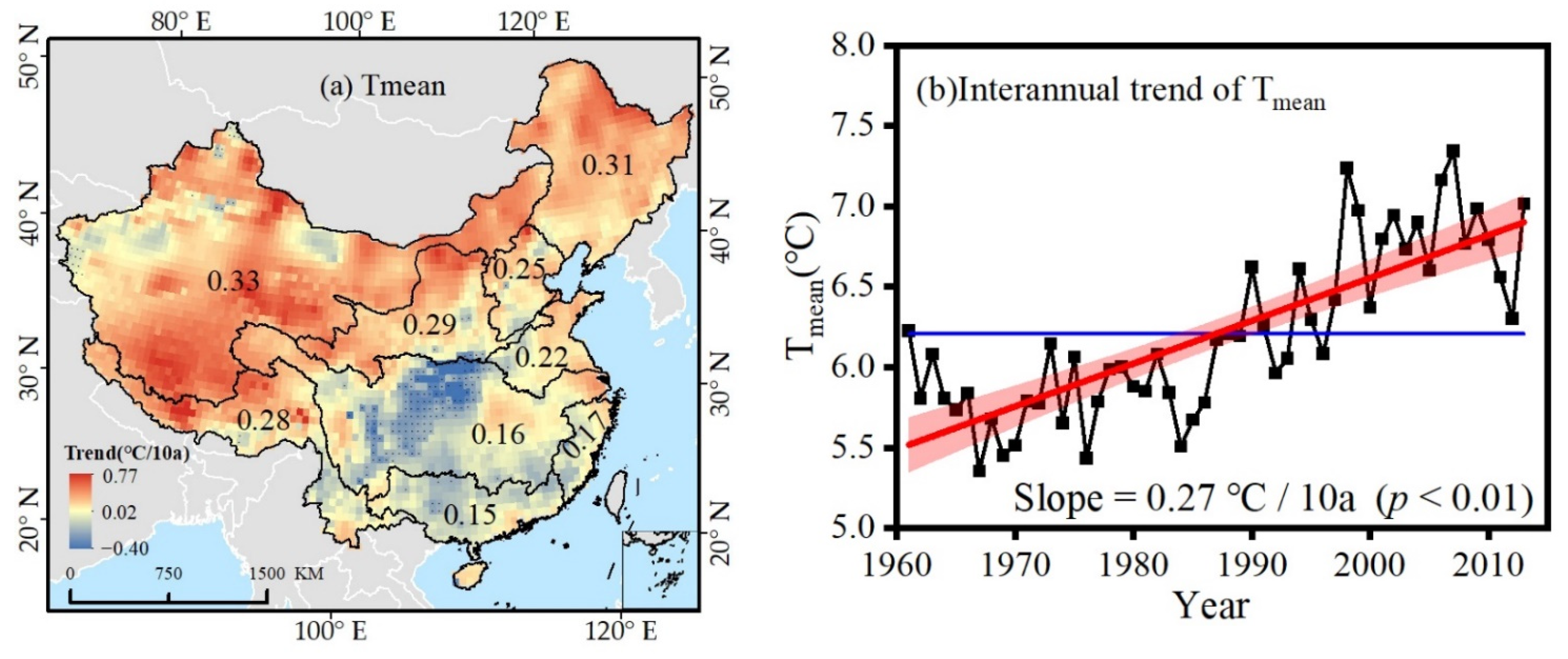
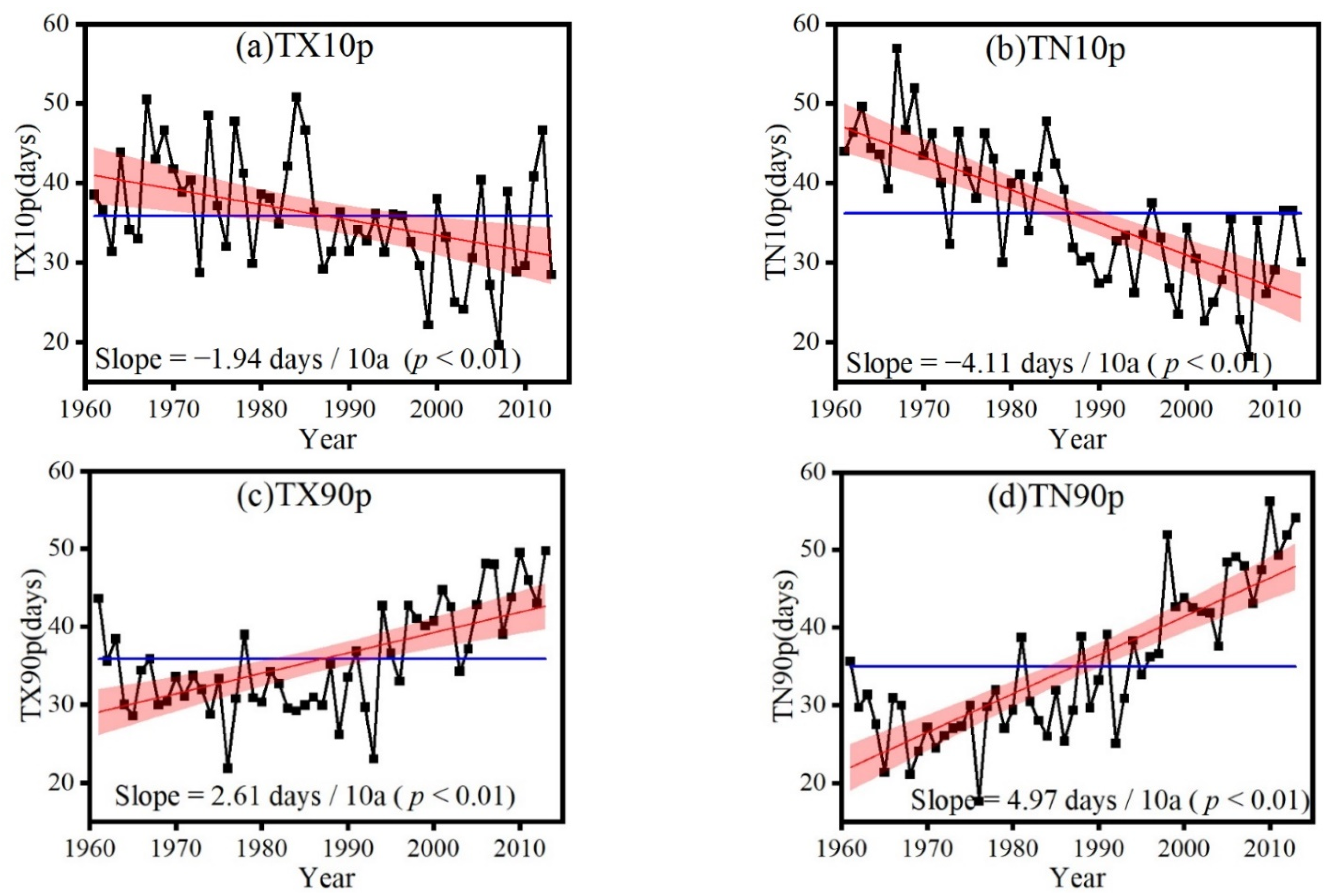
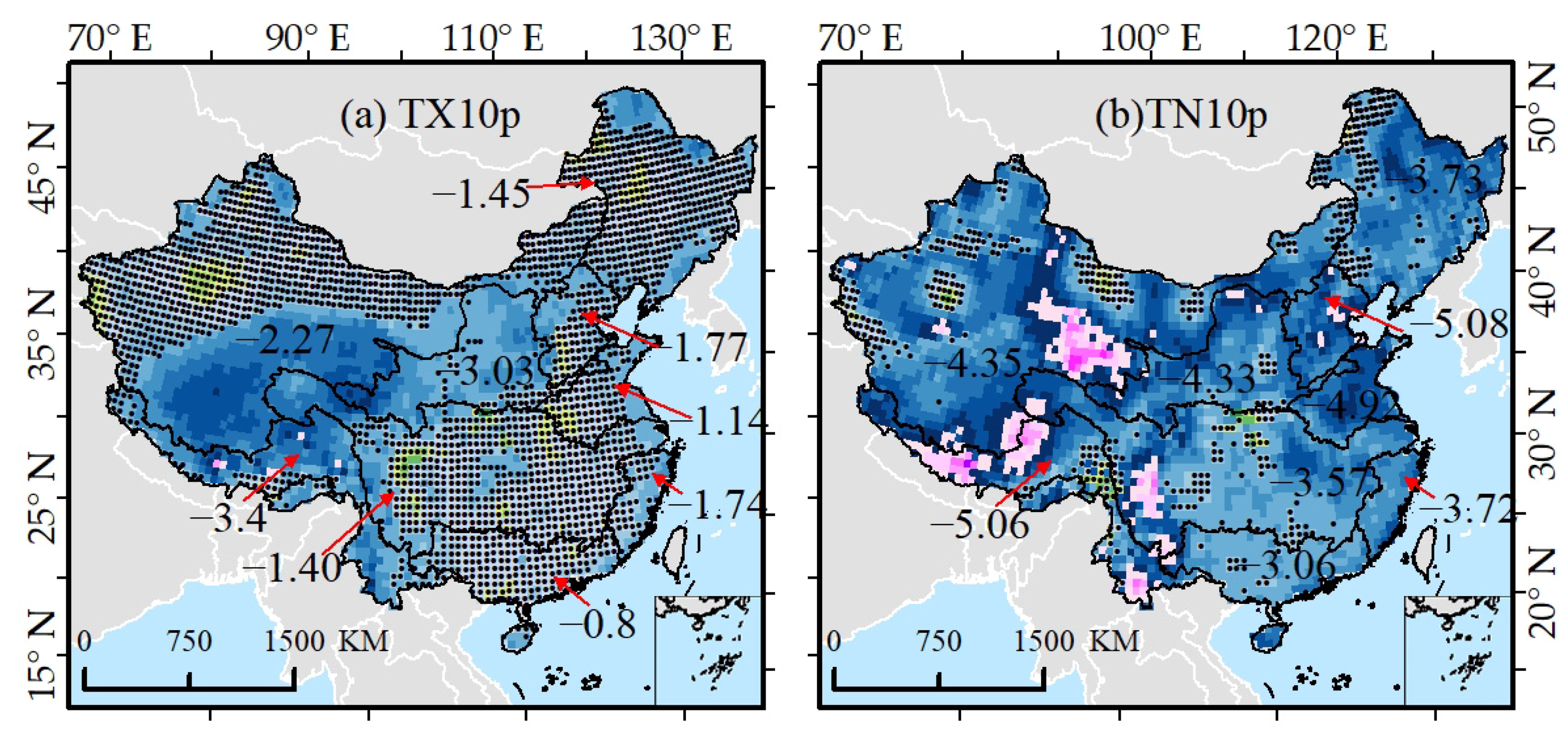
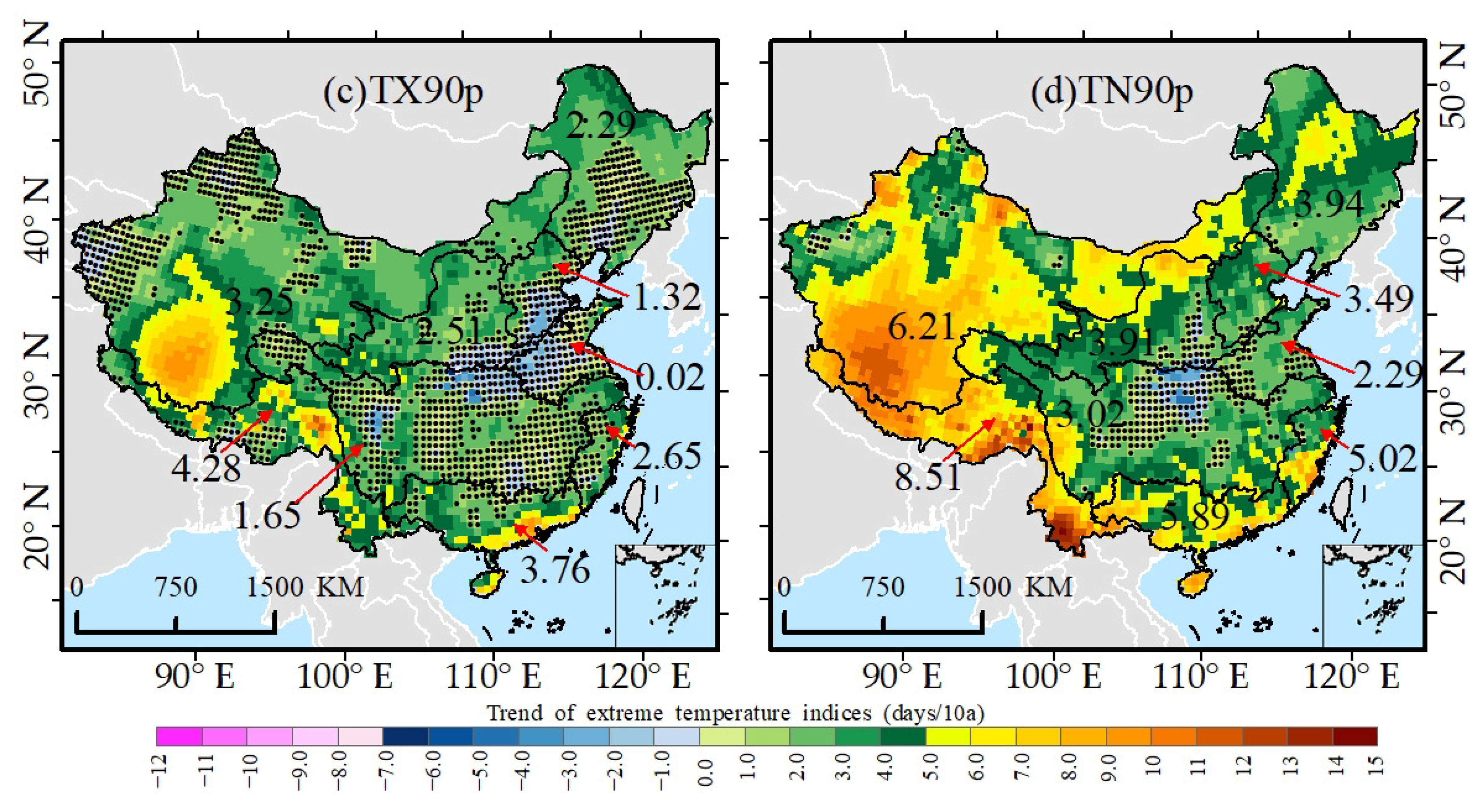
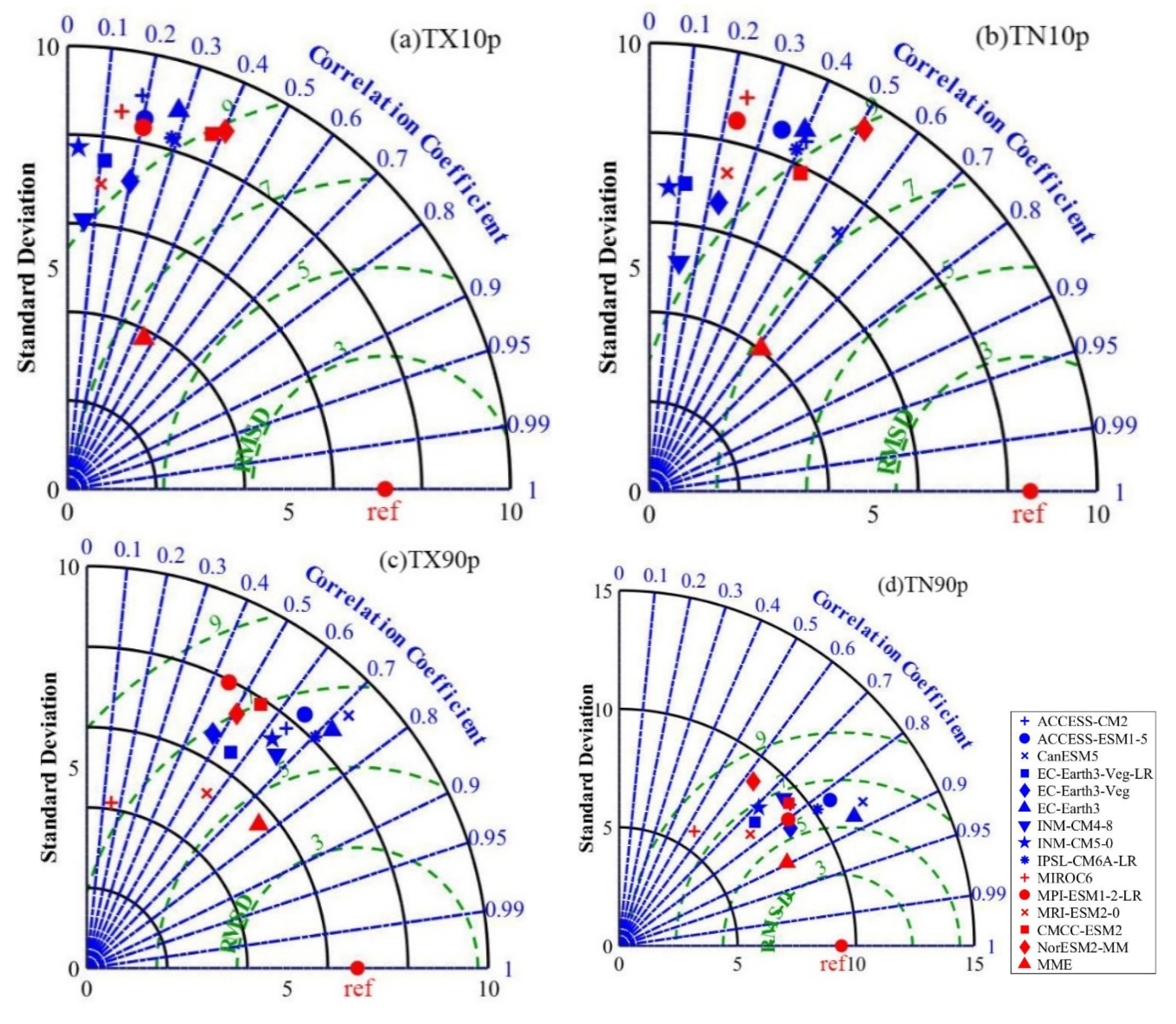





| Model | Modeling Center (or Group), Country | Resolution (Lon × Lan) |
|---|---|---|
| ACCESS-CM2 | Commonwealth Scientific and Industrial Research Organisation, Australia | 192 × 144 |
| ACCESS-ESM1-5 | ||
| CanESM2 | Canadian Centre for Climate Modelling and Analysis, Canada | 128 × 64 |
| EC-Earth3 | Agencia Estatal de Meteorología, Spain; The Swedish Meteorological and Hydrological Institute, Sweden and 30 other institutes | 512 × 256 |
| EC-Earth3-Veg | ||
| EC-Earth3-Veg-LR | ||
| FGOALS-G2 | Institute of Atmospheric Physics, Chinese Academy of Sciences, China | 180 × 80 |
| INM-CM4-8 | Institute for Numerical Mathematics, Russian | 180 × 120 |
| INM-CM5-0 | ||
| IPSL-CM6A-LR | Institut Pierre Simon Laplace, France | 144 × 143 |
| MIROC6 | Japan Agency for Marine-Earth Science and Technology, Atmosphere and Ocean Research Institute, and National Institute for Environmental Studies, Japan | 256 × 128 |
| MPI-ESM1-2-HR | Max Planck Institute for Meteorology, Germany | 384 × 192 |
| MPI-ESM1-2-LR | ||
| MRI-ESM2-0 | Meteorological Research Institute, Japan | 320 × 160 |
| Indices | Name | Description | Unit |
|---|---|---|---|
| TX10p | Cool days | Number of days when Tmax < 10th percentile | d (Days) |
| TN10p | Cool nights | Number of days when Tmin < 10th percentile | d (Days) |
| TX90p | Warm days | Number of days when Tmax > 90th percentile | d (Days) |
| TN90p | Warm nights | Number of days when Tmin > 90th percentile | d (Days) |
| Area | TX10P | TN10P | TX90P | TN90P |
|---|---|---|---|---|
| Yangtze River Basin | −0.3 ** | −0.33 ** | 0.29 ** | 0.29 ** |
| Southeast Basin | −0.33 ** | −0.35 ** | 0.16 | 0.42 ** |
| Haihe River Basin | −0.13 | −0.54 ** | 0.28 ** | 0.22 * |
| Huaihe River Basin | −0.17 * | −0.56 ** | 0.22* | 0.30 ** |
| Yellow River Basin | −0.08 | −0.53 ** | 0.33 ** | 0.22 ** |
| Continental Basin | −0.19 * | −0.34 ** | 0.30 ** | 0.33 ** |
| Songhua and Liaohe River Basin | −0.03 | −0.7 ** | 0.11 | 0.29 * |
| Southwest Basin | −0.24 ** | −0.40 ** | 0.17 * | 0.32 ** |
| Pearl River Basin | −0.5 ** | −0.27 ** | 0.23 * | 0.33 ** |
| China | −0.01 | −0.35 | 0.06 | 0.48 ** |
| Area | SSP1-2.6 | SSP2-4.5 | SSP5-8.5 | |||||||||
|---|---|---|---|---|---|---|---|---|---|---|---|---|
| TX10P | TN10P | TX90P | TN90P | TX10P | TN10P | TX90P | TN90P | TX10P | TN10P | TX90P | TN90P | |
| Yangtze River Basin | −0.39 * | 0.1 | 0.07 | 0.65 ** | −0.04 | −0.31 * | 0.13 | 0.53 ** | 0.12 | −0.39 ** | 0.23 | 0.5 ** |
| Southeast Basin | −0.19 | −0.17 | −0.06 | 0.69 ** | −0.01 | −0.35 | −0.08 | 0.71 ** | 0.11 | −0.40 ** | −0.01 | 0.71 ** |
| Haihe River Basin | 0.50 ** | −0.06 | 0.23 * | 0.22 * | −0.22 ** | −0.17 | 0.07 | 0.68 ** | −0.27 ** | −0.26 ** | 0.22 ** | 0.27 ** |
| Huaihe River Basin | −0.19 | 0.18 | 0.08 | 0.57 ** | −0.24 * | −0.15 | 0.6 ** | 0.02 | −0.19 | −0.13 | 0.38 ** | 0.31 * |
| Yellow River Basin | −0.33 ** | −0.1 | 0.22 ** | 0.38 ** | −0.17 ** | −0.24 ** | 0.17 ** | 0.73 ** | −0.20 ** | −0.21 ** | 0.28 ** | 0.31 ** |
| Continental Basin | 0.06 | −0.34 * | 0.26 | 0.44 ** | −0.54 ** | 0.12 | 0.26 | 0.34 * | −0.22 | −0.16 | 0.4 ** | 0.23 |
| Songhua and Liaohe River Basin | 0.42 | −0.71 | −0.17 | 0.76 | 0.66 | −0.93 * | −0.07 | 0.78 | 0.09 | −0.61 | 0.78 | 0.29 |
| Southwest Basin | −0.31 | 0.32 | 0.43 | 0.06 | 0.14 | −0.32 * | −0.13 | 0.94 ** | 0.32 ** | −0.57 ** | 0.42 * | 0.33 |
| Pearl River Basin | −0.6 ** | 0.38 | 0.04 | 0.68 ** | 0.05 | −0.32 | −0.12 | 0.79 ** | 0.12 | −0.37 | −0.24 | 0.95 ** |
| China | 0.09 | −0.45 ** | 0.2 | 0.44 ** | −0.27 * | −0.15 | 0.31 ** | 0.27 | −0.28 * | −0.18 | 0.54 ** | 0.00 |
Publisher’s Note: MDPI stays neutral with regard to jurisdictional claims in published maps and institutional affiliations. |
© 2022 by the authors. Licensee MDPI, Basel, Switzerland. This article is an open access article distributed under the terms and conditions of the Creative Commons Attribution (CC BY) license (https://creativecommons.org/licenses/by/4.0/).
Share and Cite
Shan, Y.; Ying, H.; Bao, Y. Changes in Extreme Temperature Events and Their Contribution to Mean Temperature Changes during Historical and Future Periods over Mainland China. Atmosphere 2022, 13, 1127. https://doi.org/10.3390/atmos13071127
Shan Y, Ying H, Bao Y. Changes in Extreme Temperature Events and Their Contribution to Mean Temperature Changes during Historical and Future Periods over Mainland China. Atmosphere. 2022; 13(7):1127. https://doi.org/10.3390/atmos13071127
Chicago/Turabian StyleShan, Yu, Hong Ying, and Yuhai Bao. 2022. "Changes in Extreme Temperature Events and Their Contribution to Mean Temperature Changes during Historical and Future Periods over Mainland China" Atmosphere 13, no. 7: 1127. https://doi.org/10.3390/atmos13071127
APA StyleShan, Y., Ying, H., & Bao, Y. (2022). Changes in Extreme Temperature Events and Their Contribution to Mean Temperature Changes during Historical and Future Periods over Mainland China. Atmosphere, 13(7), 1127. https://doi.org/10.3390/atmos13071127






